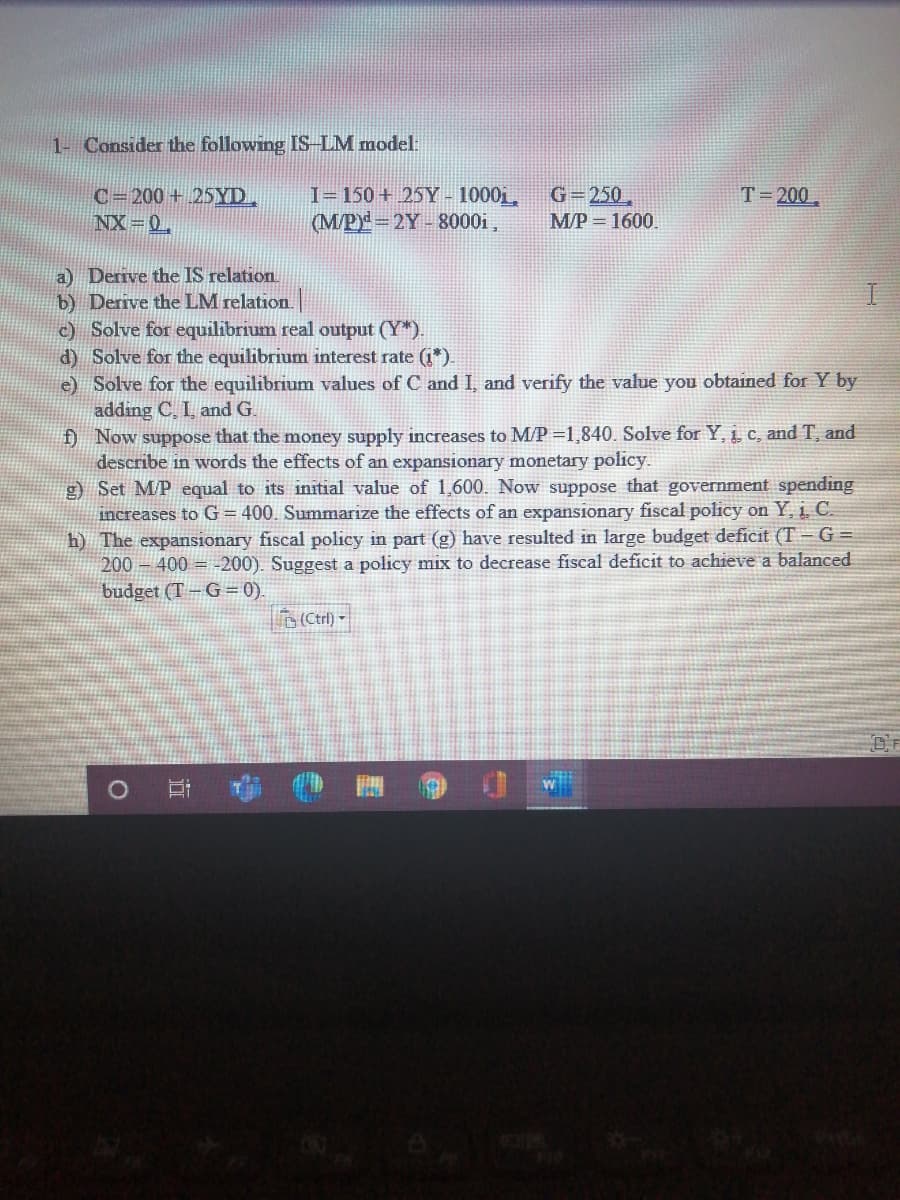1- Consider the following IS-LM model: I= 150 + 25Y - 1000i, (M/P)=2Y - 8000i, G=250, T=200. C=200 + 25YD NX = 0 M/P = 1600. %3D a) Derive the IS relation b) Derive the LM relation c) Solve for equilibrium real output (Y*).
1- Consider the following IS-LM model: I= 150 + 25Y - 1000i, (M/P)=2Y - 8000i, G=250, T=200. C=200 + 25YD NX = 0 M/P = 1600. %3D a) Derive the IS relation b) Derive the LM relation c) Solve for equilibrium real output (Y*).
Chapter1: Making Economics Decisions
Section: Chapter Questions
Problem 1QTC
Related questions
Question

Transcribed Image Text:1- Consider the following IS-LM model:
I= 150 + 25Y - 1000i,
(M/P 2Y 8000i,
G=250,
T= 200
C=200 + 25YD.
NX 0,
M/P = 1600.
a) Derive the IS relation
b) Derive the LM relation.
c) Solve for equilibrium real output (Y*).
d) Solve for the equilibrium interest rate (i*)
e) Solve for the equilibrium values of C and I, and verify the value you obtained for Y by
adding C, I, and G.
) Now suppose that the money supply increases to M/P =1,840. Solve for Y, i c, and T, and
describe in words the effects of an expansionary monetary policy.
g) Set M/P equal to its initial value of 1,600. Now suppose that government spending
increases to G = 400. Summarize the effects of an expansionary fiscal policy on Y, 1. C.
h) The expansionary fiscal policy in part (g) have resulted in large budget deficit (T= G =
200 – 400 = -200). Suggest a policy mix to decrease fiscal deficit to achieve a balanced
budget (T = G = 0).
b(Ctrl) -
立
Expert Solution
This question has been solved!
Explore an expertly crafted, step-by-step solution for a thorough understanding of key concepts.
Step by step
Solved in 4 steps

Knowledge Booster
Learn more about
Need a deep-dive on the concept behind this application? Look no further. Learn more about this topic, economics and related others by exploring similar questions and additional content below.Recommended textbooks for you


Principles of Economics (12th Edition)
Economics
ISBN:
9780134078779
Author:
Karl E. Case, Ray C. Fair, Sharon E. Oster
Publisher:
PEARSON

Engineering Economy (17th Edition)
Economics
ISBN:
9780134870069
Author:
William G. Sullivan, Elin M. Wicks, C. Patrick Koelling
Publisher:
PEARSON


Principles of Economics (12th Edition)
Economics
ISBN:
9780134078779
Author:
Karl E. Case, Ray C. Fair, Sharon E. Oster
Publisher:
PEARSON

Engineering Economy (17th Edition)
Economics
ISBN:
9780134870069
Author:
William G. Sullivan, Elin M. Wicks, C. Patrick Koelling
Publisher:
PEARSON

Principles of Economics (MindTap Course List)
Economics
ISBN:
9781305585126
Author:
N. Gregory Mankiw
Publisher:
Cengage Learning

Managerial Economics: A Problem Solving Approach
Economics
ISBN:
9781337106665
Author:
Luke M. Froeb, Brian T. McCann, Michael R. Ward, Mike Shor
Publisher:
Cengage Learning

Managerial Economics & Business Strategy (Mcgraw-…
Economics
ISBN:
9781259290619
Author:
Michael Baye, Jeff Prince
Publisher:
McGraw-Hill Education